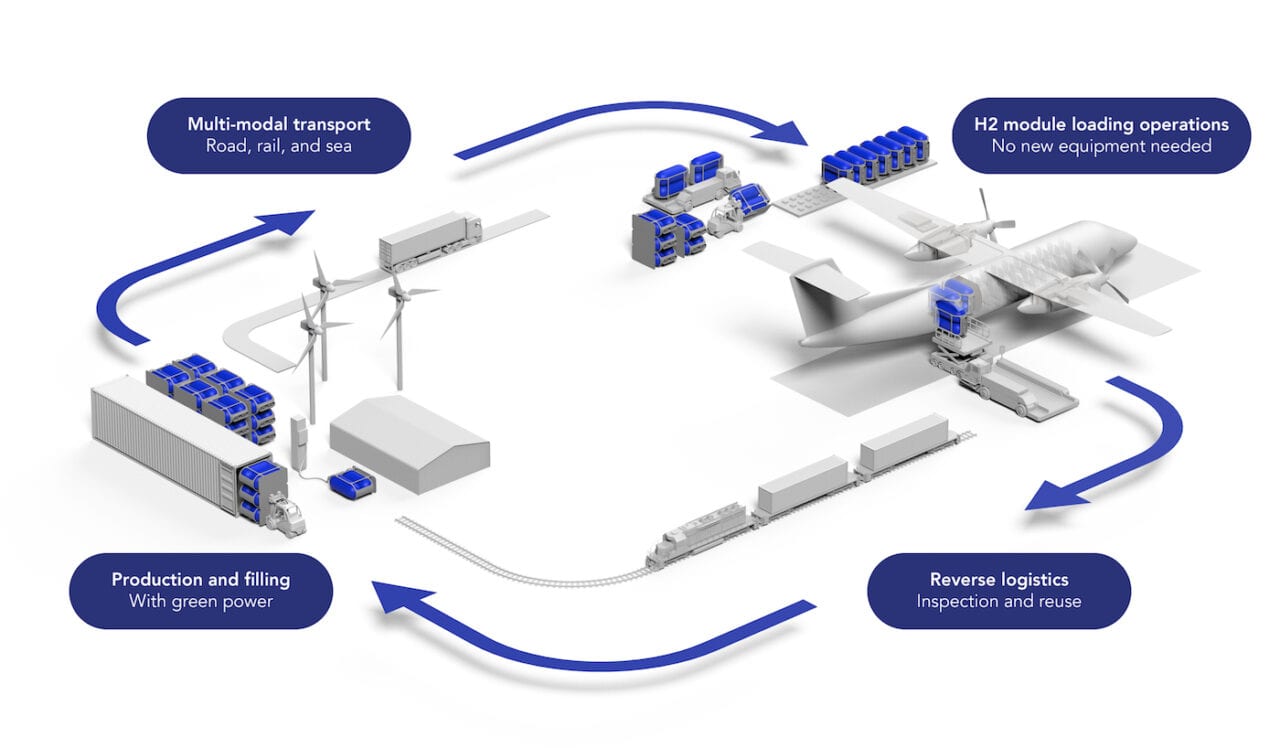
Universal Hydrogen emerged from stealth in late August with a disruptive new concept of operations for aircraft hydrogen power distribution. (Universal Hydrogen)
Distribution of hydrogen power to regional turboprop aircraft could become a reality by the mid 2020s, according to a disruptive new California-based green startup that is already talking to airlines and airplane manufacturers about their concept.
Universal Hydrogen CEO Paul Eremenko and COO Jason Chua explained to Aviation Today how they envision using the global intermodal freight network to eliminate the need for infrastructure and provide hydrogen power for passenger carrying regional airline flights in the near future during a recent interview. The company has multiple patents pending associated with its invention of hydrogen storage pods capable of generating enough power to initially enable flight operations on short haul regional airline flights.
“A really important point to just make very clear is that we’re not an airplane company and we do not aspire to be an airplane company. We are a hydrogen logistics company and we would like to serve as many different aviation market segments with hydrogen as possible,” Eremenko said.
According to an information sheet provided by the startup, the modular capsule is “2X more weight-efficient than traditional hydrogen storage” and is part of a “retrofit package for existing regional aircraft using mature electric motor and fuel cell technologies.” De Havilland’s Canada Dash-8 Q-300 and the ATR-42 are some of the regional aircraft types that have already had discussions with Eremenko, Chua and their other co-founders – a team of former UTC executives who left the company after the Raytheon merger.

The two-capsule hydrogen storage pods are part of a retrofit conversion kit that has been developed for regional turboprop aircraft types. Transportation across the intermodal network converts hydrogen to dry freight, with a focus on travel from the point of consumption to airports. (Universal Hydrogen)
Rather than trying to develop the infrastructure required to store, develop and distribute hydrogen, their capsule converts hydrogen to dry freight to enable transportation from the point of consumption to airports where aircraft need refueling. Their design takes advantage of the concept of intermodal freight, which uses containers that can be transported through a variety of vehicles including ships, semi-trailer trucks, and trains.
Entry into service within the next five years is envisioned by Eremenko and his co-founders with a three phased process. Over the next year, under Phase A the hydrogen capsules will be developed and tested at full-scale to include an end-to-end demonstration of their intermodal power distribution concept from the point of production to an “aircraft-scale ground testbed for fuel cell powertrain.”
Phase B includes achievement of air transport certification for their capsules prior to Phase C: “mass industrialization of the capsules and FAA certification of a hydrogen-powered regional turboprop carrying 40 passengers with up to 500 nm range,” the startup notes on their information sheet.
“Initially we will focus on the regional turboprop aircraft segment. We think that it’s a good proof point for anything bigger. Eventually we want to be able to tackle the single aisle market because that is where the majority of the world’s passenger miles are flown, and that’s where the majority of fuel burn and carbon emissions happen,” Chua said.

Universal Hydrogen’s Dash-8 rendering shows the use of six capsules required, or three modules of two capsules each. The Dash-8 will require 2 megaWatt power motors. (Universal Hydrogen)
“But it’s also a great proof point for anything smaller: a small commuter turboprop like a Cessna SkyCourier or the [urban air mobility] UAM market as it emerges,” he added.
Based on the decades of aerospace industry experience of its co-founders, Universal Hydrogen has also considered the business model and value proposition for their invention as well. Other co-founders for the company include former senior executives from Airbus, Google and DARPA. Retired Airbus CEO Tom Enders is also serving within an advisory role to the company.
Emerging from stealth in late August, Universal Hydrogen is one of several companies making advancements toward the enablement of hydrogen-powered regional turboprops. In June, ZeroAvia – a Silicon Valley startup – made headlines by completing the first phase of test flights for the U.K.’s first ever electric-powered commercial-scale aircraft.
ZeroAvia and its partners for Project HyFlyer are now preparing for the next round of flight-testing using the hydrogen electric powertrain that they ultimately want to use for zero emissions passenger carrying aircraft. In that system, the power inverters and electric motors still drive the propeller, however the electricity is provided by the hydrogen fuel cell system in place of the battery.
On Sept. 10, ZeroAvia received its first Toyota Mirai fuel cell car at its Cranfield base, where it will form an important part of the company’s ground-breaking Hydrogen Airport Refueling System (HARE). The company has also partnered with the European Marine Energy Centre (EMEC) that has “has developed mobile hydrogen refueling infrastructure to supply fuel to the aircraft, featuring a self-contained hydrogen production and refueling capacity,” according to a Toyota press release.
Eremenko said discussions for Universal Hydrogen about FAA supplemental type certification have already begun. Other progress-to-date includes more than $1 million in engineering work complete, conceptual design disclosures and the identification of “all critical development partners.”
“When you look at the single aisle market, both Airbus and Boeing—and probably COMAC—are going to do a new single aisle in the next decade,” Eremenko said. “And as they’re making those technology decisions [in the mid-2020’s] for what their next aircraft will use, we want to be out there on the market, actively supplying hydrogen and showing that we have solved the infrastructure problem and addressed their biggest risk for launching a hydrogen single aisle.”